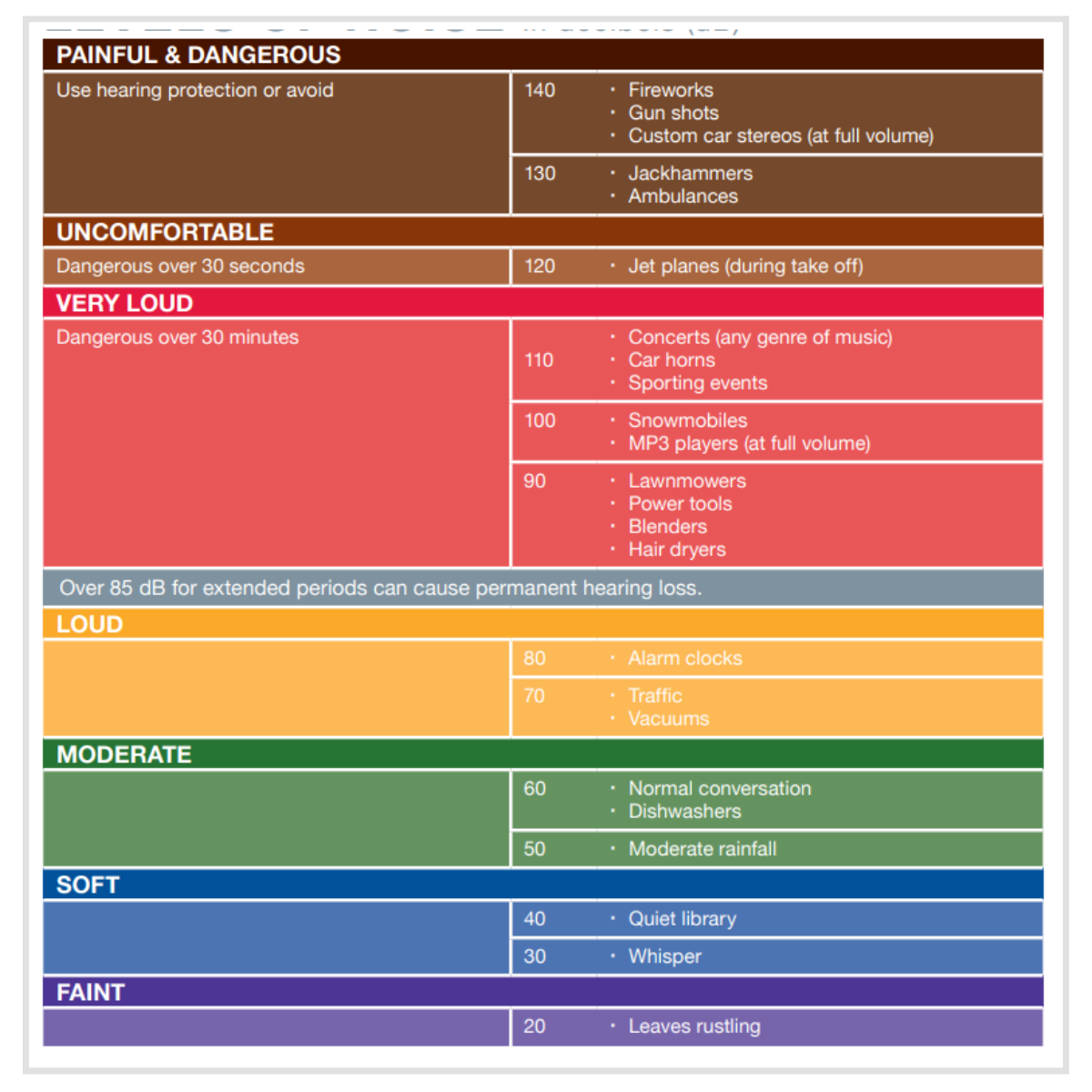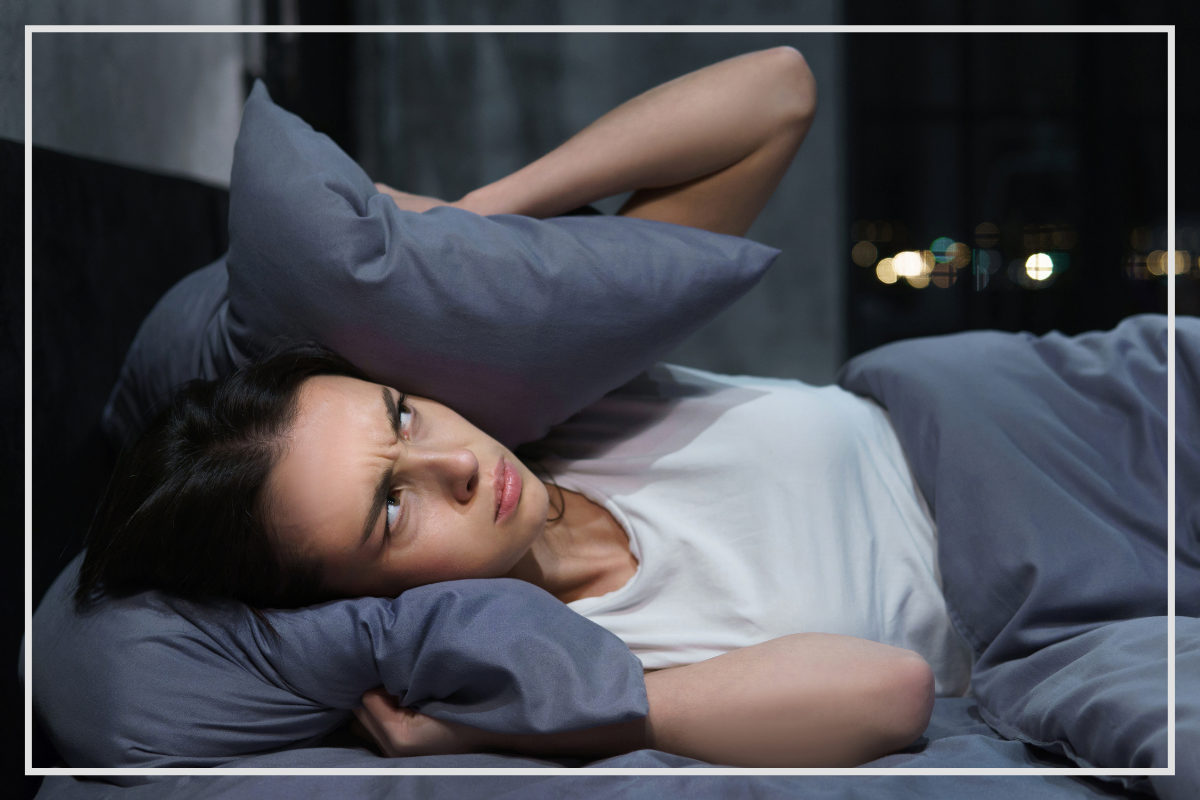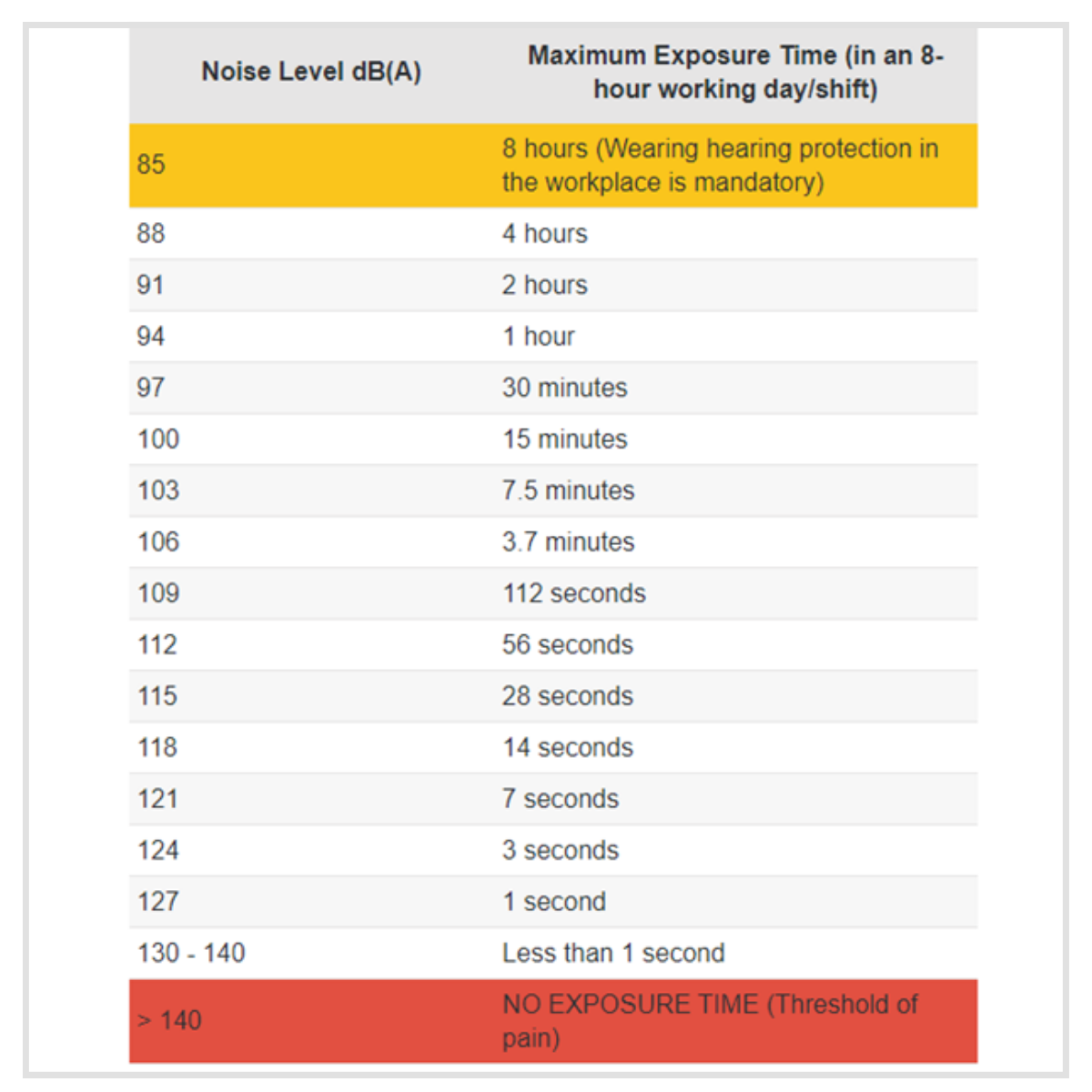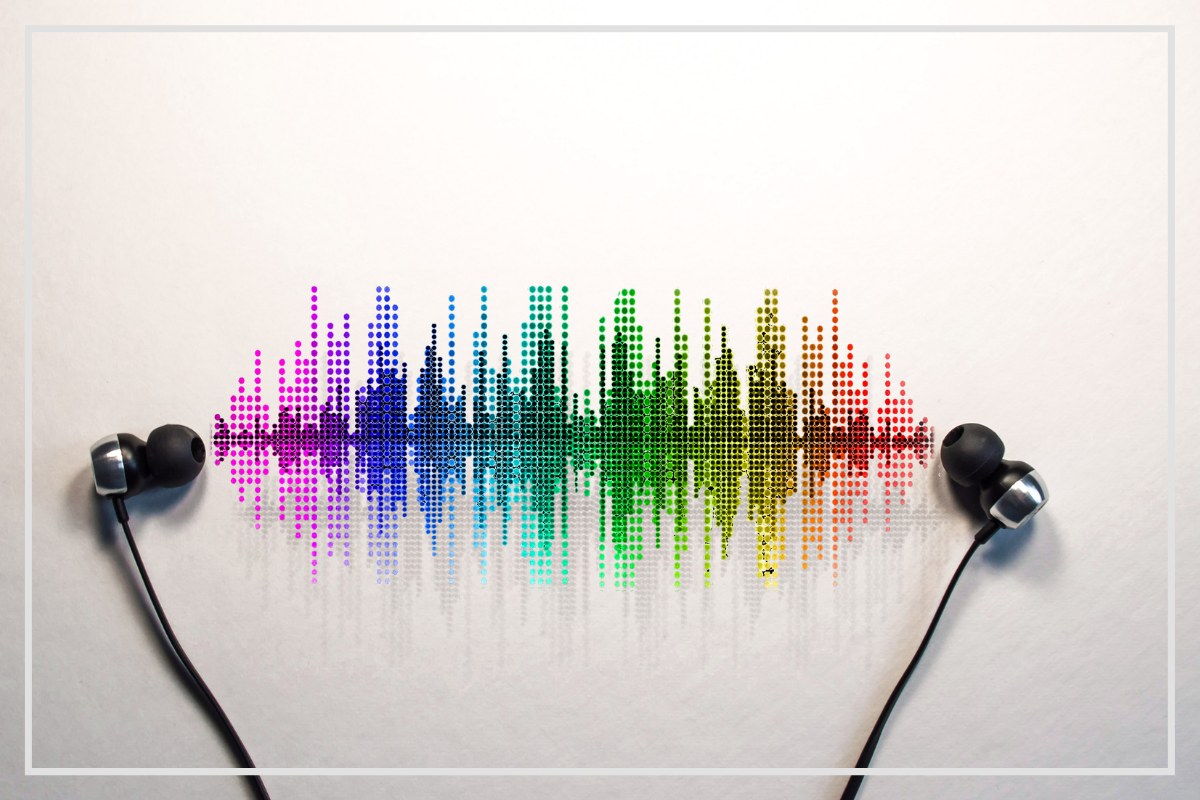- How Decibel Levels Are Measured
- Decibel Level Chart of Common Sounds
2.1 Painful & Dangerous
2.2 Uncomfortable
2.3 Very Loud
2.4 Irritating
2.5 Loud
2.6 Moderate
2.7 Soft
2.8 Very Quiet
2.9 Barely Audible - Noise Level Chart and Maximum Exposure Time
- Tips to Prevent Damage to Your Hearing
4.1 Beware of the Noise Levels Around You
4.2 Take Care When Listening to Music
4.3 Avoid Being Exposed to Loud Noises
4.4 Wear Hearing Protection If Necessary
4.5 Test Your Hearing Regularly - Measure the Sound Level Around You With Decibel Pro App
The human ear is very sensitive and perceives even the smallest differences in sound intensity. However, we may not always be aware of just how loud some sounds can be.
In this article, we’re using a comprehensive decibel chart of common sounds to compare different decibel levels. Using this chart, you can be more aware of the noise levels that can cause hearing damage and protect your hearing.
How Decibel Levels Are Measured
To measure the noise level of different sounds, we use a measurement unit called the decibel (dB). It represents a sound’s intensity. To measure a sound’s frequency, we use the hertz (Hz).
Each time a sound’s decibel level increases by 10, its intensity multiplies by 10. However, the decibel scale is logarithmic, not linear. Therefore, a 10 dB sound is 10 times more intense than a 0 dB sound, a 20 dB sound is 100 times more intense, and a 30 dB sound is 1,000 times more intense.
We use the decibel scale to determine how loud sounds are and if they are safe or harmful to human hearing. The range of sounds measured on the decibel scale is from 0 dB (the quietest sound) to 140 dB (the threshold of pain).
Sounds above 85 dB are considered by specialized organizations like NIOSH (the US National Institute for Occupational Safety and Health) to be dangerous to human hearing. This means sounds above this level can result in hearing damage or hearing loss depending on the duration of your exposure.
Decibel Level Chart of Common Sounds
The intensity of common sounds ranges from 0 dB to 140 dB. Looking at a decibel chart such as the one below, we can determine if those sounds are safe, potentially harmful, or outright dangerous for our ears.

In addition to the illustration above, you can also use the details below to help guide you and determine if a decibel level is safe or not.
Painful & Dangerous
Decibel levels ranging from 120 to 140 dB are very dangerous to human hearing and also painful. Even the shortest direct exposure to such loud sounds can cause eardrum rupture and instant hearing loss.
Common sources of painful and dangerous noises with a level between 120 and 140 dB include:
· aircraft taking off;
· thunderclap;
· jackhammer or chainsaw;
· gunshot from a high-caliber gun or firearm like a rifle or a shotgun.
Uncomfortable
Sounds between 110 and 120 dB are considered unsafe for human hearing. They can be very uncomfortable and even cause pain and they can instantly damage your hearing.
Common sources of 110-120 dB sound include:
· jet plane or helicopter;
· rock concert or symphony orchestra;
· large scale sporting events;
· car horn;
· leaf blower;
· power saw.
Very Loud
Sounds above 80 dB and up to 110 dB are considered very loud. The general rule is that all sound levels exceeding 85 decibels are not only very loud, but also harmful to human hearing and potentially dangerous. Specialists recommend you use hearing protection whenever you are exposed to sounds above 85 dB.
Common examples of 80-110 dB sounds include:
· playing music on your personal listening device or audio system at maximum volume - 100 dB;
· power tools – 90 dB;
· alarm clocks – 80 dB.

Irritating
Although noise levels between 70 and 80 dB are not considered dangerous, they can sometimes be irritating or even annoying. This is especially true if you are trying to focus on something such as when you are working or studying.
For school children, this noise level can affect reading and comprehension acquisition. For adults, prolonged exposure to noise levels in this range can cause stress and increase blood pressure levels.
Here are some day-to-day sounds between 70 and 80 dB:
· garbage disposal or vacuum cleaner – 80 dB;
· car tires – 70 dB;
· average traffic noise – 70 dB.
Loud
Sounds ranging from 60 to 80 dB are not dangerous to human hearing. Nevertheless, they are still considered loud.
The most common examples of sounds in this range are:
· busy restaurant – 70 to 80 dB;
· loud radio – 70 to 75 dB;
· city street – 70 dB;
· hairdryer – 70 dB;
· dishwasher – 70 dB;
· electric shaver – 60 dB;
· normal conversation – 60 dB.
Moderate
Moderate noises are between 40 and 60 decibels. These levels are acceptable no matter how long you are exposed to them, and they are not considered potentially harmful to your hearing.
Examples of moderate sounds include:
· normal level of speech;
· rainfall;
· refrigerator;
· light traffic;
· a residential street.
Soft
Soft sounds, as the name suggests, are very mild and range from 20 to 40 dB. They are safe for your hearing, and you can be exposed to these noise levels for an indefinite amount of time.
Examples of soft sounds include:
· a quiet room;
· a person whispering;
· the sound of rustling leaves;
· a silent library.

Very Quiet
Sounds from 10 to 20 dB are very quiet and safe for your ears. These sounds are slightly louder than the sound of your breath, which is 10 dB, or the equivalent of a quiet whisper or of wind blowing over a leaf.
Barely Audible
Although our ears are very sensitive and precise, we cannot hear all sounds. Some are too quiet to perceive or make out. Barely audible sounds like the sound of a person breathing or a leaf resting range from 0 to 10 decibels.
Noise Level Chart and Maximum Exposure Time
The amount of time you are exposed to a certain decibel level will determine the potential of hearing damage or loss. While you can safely be exposed to some levels for a few hours, other levels can cause pain or even hearing loss if you are exposed to them for even one minute.
Use the figure below to see how long you can safely expose yourself to different noise levels:

Maximum exposure times differ for Europe and the US. In Europe, every time there is a 3 dB increase, the recommended maximum exposure time drops to half. In the US, the recommended maximum exposure time drops to half every time the noise level increases by 5 dB.
If you want to measure your noise exposure over a day or a certain amount of time, you need to use a noise dosimeter. This is a special instrument usually placed on the exposed person’s shoulder or close to their ear. It constantly measures and monitors noise levels and determines the average noise exposure of the individual.
You can also use a noise dosimeter such as the one included in the Decibel Pro app to make these readings.
Noise dosimeters are typically used in industrial environments or construction sites.
Using data from a noise dosimeter, employers can determine whether a worker is exposed to potentially harmful levels. If they are, employers can take special measures to prevent hearing damage and protect the worker’s hearing.
These measures can include:
· providing appropriate hearing protection gear
· reducing the duration of the worker’s shift to allow for rest in between exposure to loud noise levels
· changing the equipment used by the worker with quieter equipment
· fitting the equipment used by the worker with special sound-dampening attachments
· installing sound barriers
Tips to Prevent Damage to Your Hearing
Here are a few simple tips to prevent damage to your hearing you can apply if you find yourself in a situation where you are exposed to loud noises:
Beware of the Noise Levels Around You
The best preventive measure you can take to prevent damage to your hearing is to monitor noise levels. By measuring noise levels at your workplace or in your home, you can identify potentially harmful noise levels and take action to protect your hearing.
You can use a sound level meter or a sound level meter app to measure noise levels.
Take Care When Listening to Music
A common cause of hearing damage is listening to loud music. Whether it’s on your headphones or speakers, loud music can damage your ears and lead to hearing damage.
Depending on how loud you enjoy listening to music, use the decibel grid above to calculate maximum exposure times.
Avoid Being Exposed to Loud Noises
You can avoid being exposed to loud noises and damaging your hearing by measuring and being aware of the noise levels around you and wearing hearing protection or distancing yourself from the noise source.
Wear Hearing Protection If Necessary
If you are in a circumstance where you cannot avoid exposure to loud noises, such as if you work in a factory or on a construction site, you must wear appropriate hearing protection. You can choose from earplugs, earmuffs, or noise-canceling headphones.
Test Your Hearing Regularly
The best way to identify hearing issues early on and prevent further damage is to test your hearing regularly. You can get your hearing tested by going to an audiologist or using Decibel Pro.
Measure the Sound Level Around You With Decibel Pro App
The easiest way to check the decibel readings of common sounds is to use a professional app like Decibel Pro. Using it, you can measure the sound levels around you and take measures to protect your hearing if necessary.
Decibel Pro also has other integrated features that prevent hearing damage and loss, such as the noise dosimeter you can use to get a rating of your daily noise exposure, and the hearing test you can take regularly to stay on top of your hearing health.
In addition, Decibel Pro has an integrated hi-fi spectrum analyzer that provides specialized data about sounds on a comprehensive graph.
To download Decibel Pro, go to the AppStore, or click here to learn more about it.



